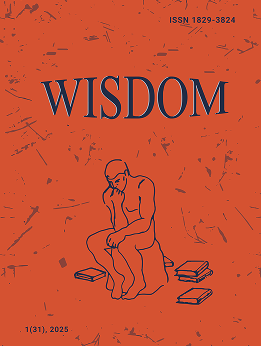Methodological Analysis of Feminist Challenges in Indian Mines
DOI:
https://doi.org/10.24234/wisdom.v25i1.930Keywords:
feminism, modernity, mining, hindrances, regulationsAbstract
This paper draws on a qualitative philosophical investigation to examine and create understanding of existing feminist problems in the coal mining industry in modern society. An attempt is made to understand the diachrony of gender stereotype phenomena and provisions that lead to female obstacles on their direct interaction at workplace across businesses by contextualising current occurrences from the Mining Industry. The findings will most likely aid in boosting the percentage of women working in productive capacities and offering answers that contribute to the long-term viability of the business.
Downloads
References
Alway, S. E., Grumbt, W. H., Gonyea, W. J., & Stray-Gundersen, J. (1989). Contrasts in muscle and myofibers of elite male and female bodybuilders. Journal of Applied Physiology, 67(1), 24-31. DOI: https://doi.org/10.1152/jappl.1989.67.1.24
Appel, M. (2009). Minister concerned at mine safety report findings. Retrieved July 16, 2021 from www.buanews.gov.za/rss/09/09020216151001
Bose, S. (2004). Positioning women within the environmental justice framework: A case from the mining sector. Gender, Technology and Development, 8(3), 407-412. DOI: https://doi.org/10.1080/09718524.2004.11910125
Botha, D. (2016). Women in mining still exploited and sexually harassed. SA Journal of Human Resource Management, 14(1), 1-12. DOI: https://doi.org/10.4102/sajhrm.v14i1.753
Corral-Verdugo, V., Pato, C., & Torres-Soto, N. (2021). Testing a tridimensional model of sustainable behavior: Self-care, caring for others, and caring for the planet. Environment, Development and Sustainability, 23(9), 12867-12882. DOI: https://doi.org/10.1007/s10668-020-01189-9
De Klerk, I., Botha, C. J., & Botha, D. (2015). The perception on women working in core mining environment. Journal of Economics, Delhi, 6(2), 200-211. http://hdl.handle.net/10394/20504 DOI: https://doi.org/10.31901/24566594.2015/06.02.12
Frey, R., & Bellotti, C. (1995). Pro-feminist educational programs run by men for male offenders: Is it wise? Is it possible? In D. Chappell and S. J. Egger (Eds.), Australian violence: Contemporary perspective (pp. 139-153). Canberra: Australian Institute of Criminology
Garner, J. D. (1999). Feminism and feminist gerontology. Journal of Women & Aging, 11(2-3), 3-12. DOI: https://doi.org/10.1300/J074v11n02_02
Ghose, A. K. (2003, August). Why Longwall in India has not succeded as in other developing countries like China. Institute of Engineers (I) Journal - MN, 84, 1-4.
Gregoratti, C. (2018). Feminist perspectives on the UN womenís empowerment principles. In Handbook on the international political economy of gender (pp. 211-224). Edward Elgar Publishing. DOI: https://doi.org/10.4337/9781783478842.00022
Guha, B. P. (1996). Voluntary retirement schemes in Indian industries. Indian Journal of Industrial Relations, 31(3), 378-391.
Hacker, J. D., Hilde, L., & Jones, J. H. (2010). The effect of the Civil War on southern marriage patterns. The Journal of southern history, 76(1), 39.
Hansen, J. T. (2009). Self-awareness revisited: Reconsidering a core value of the counseling profession. Journal of Counseling & Development, 87(2), 186-193. https://doi.org/10.1002/j.1556-6678.2009.tb00566.x DOI: https://doi.org/10.1002/j.1556-6678.2009.tb00566.x
Hinde, J. R. (1997). ìSTOUT LADIES AND AMAZONSî: Women in the British Columbia coal-mining community of Ladysmith, 1912-14. BC Studies: The British Columbian Quarterly, 114, 33-57.
Hooks, B. (2000). Feminist theory: From margin to center. Pluto Press.
Janssen, I., Heymsfield, S. B., Wang, Z., & Ross, R. (2000). Skeletal muscle mass and distribution in 468 men and women aged 18ñ88 yr. Journal of Applied Physiology, 89(1), https://doi.org/10.1152/jappl.2000.89.1.81 DOI: https://doi.org/10.1152/jappl.2000.89.1.81
Kleinberg, S. J. (1976). Womanís work. ìThe housewife, past and presentî by Ann Oakley (Book Review). Journal of Social History, 10(1), 99. DOI: https://doi.org/10.1353/jsh/10.1.99
Lahiri-Dutt, K. (2020). The act that shaped the gender of industrial mining: Unintended impacts of the British mines act of 1842 on womenís status in the industry. The Extractive Industries and Society, 7(2), 389-397. https://doi.org/10.1016/j.exis.2019.02.011 DOI: https://doi.org/10.1016/j.exis.2019.02.011
Laite, J. A. (2009). Historical perspectives on industrial development, mining and prostitution. The Historical Journal, 52(3), 739-761. https://doi.org/10.1017/S0018246X09990100 DOI: https://doi.org/10.1017/S0018246X09990100
Ministry of Labour Notifies Rules To Allow Employment of Women in Mines. (2019). https://pib.gov.in/newsite/PrintRelease.aspx?relid=187977
Norwood, G. (2013). Promoting self care and well-being among feminist activists and womenís rights defenders: Reflections from Burma and Palestine. Santa Fe, NM: Upaya Zen Center. https://womenforpeaceandjustice.org/wp-content/uploads/2015/11/NorwoodPromotingSelfCare-11.pdf
O'Faircheallaigh, C. (2013). Extractive industries and Indigenous peoples: a changing dynamic? Journal of Rural Studies, 30, 20-30. DOI: https://doi.org/10.1016/j.jrurstud.2012.11.003
Sengupta, D. (2014, March 29). Coal Indiaís ìvoluntary retirement schemeî for women becomes a reality but miniscule number will benefit. The Economic Times. Retrieved July 20, 2022, from https://economictimes.indiatimes.com/industry/indl-goods/svs/metals-mining/coal-indias-voluntary-retirement-scheme-for-women-becomes-a-reality-but-miniscule-number-will-benefit/articleshow/32867866.cms
Venkata Ratnam, C.S., & Jain, H.C. (2002). Women in trade unions in India. International Journal of Manpower, 23(3), 277-292. DOI: https://doi.org/10.1108/01437720210432239
Downloads
Published
How to Cite
Issue
Section
License
Copyright (c) 2023 Priya SINGH, Avinash KUMAR, Ajit KUMAR BEHURA

This work is licensed under a Creative Commons Attribution-NonCommercial 4.0 International License.
Creative Commons Attribution-Non-Commercial (CC BY-NC). CC BY-NC allows users to copy and distribute the article, provided this is not done for commercial purposes. The users may adapt – remix, transform, and build upon the material giving appropriate credit, and providing a link to the license. The full details of the license are available at https://creativecommons.org/licenses/by-nc/4.0/.















